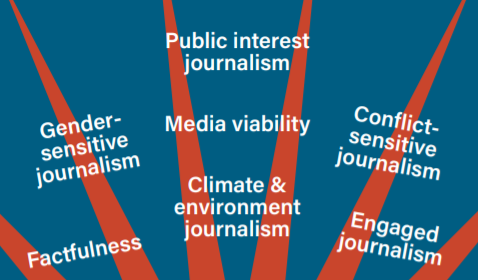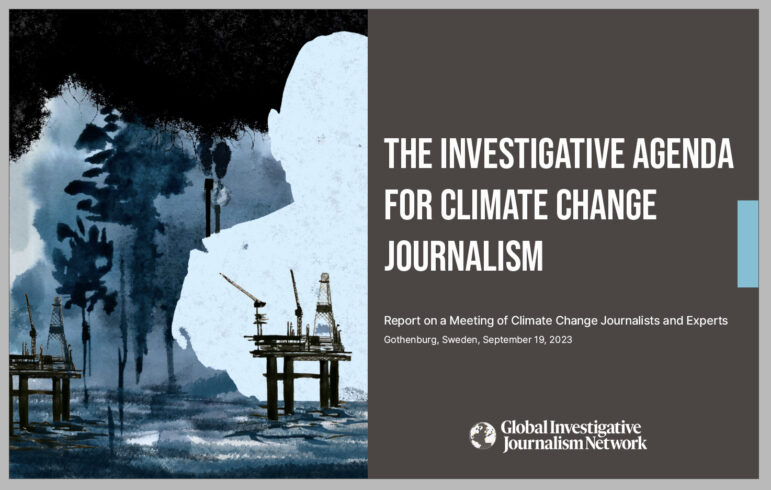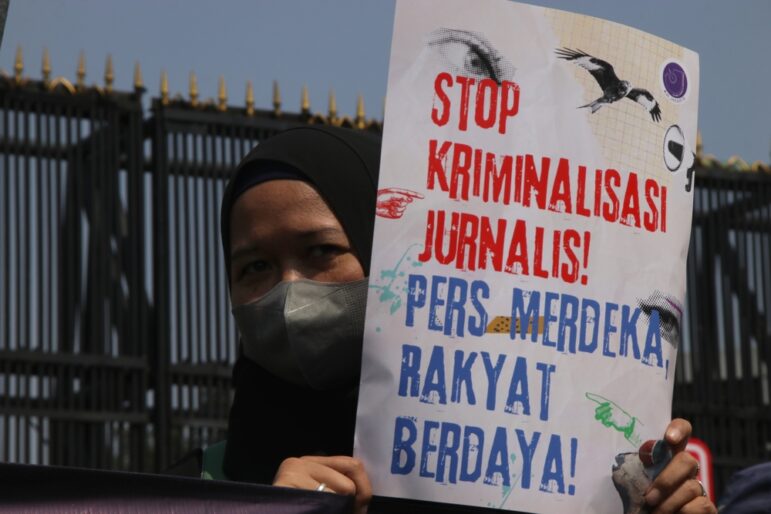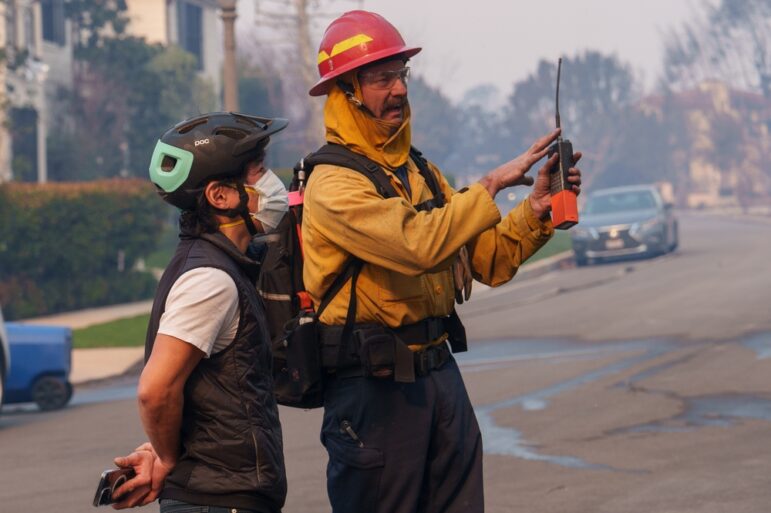

From Traditional Journalism to Sustainable Journalism
Whenever you engage in journalistic activity, ask yourself: “How does this affect sustainability?” If you do so, you are already on the threshold of practicing sustainable journalism.
The concept is obviously about journalism in relation to sustainable development, and departs from two contemporary sustainability crises:
- The sustainability crisis of society related to climate change, democracy, poverty, inequality, and armed conflicts.
- The sustainability crisis of journalism related to decrease in revenues, capture of the media, disinformation, clickbait journalism, and deteriorating trust in the media.
Sustainable journalism suggests that these crises are intrinsically intertwined. A sustainable society — economically, ecologically, and socially — requires a journalism that addresses the sustainability challenges facing society, and a sustainable future for journalism as a practice and business depends on its capability to do precisely that.
Sustainable journalism is concerned with how decisions, processes, and activities will affect the possibilities for future generations — our children and grandchildren — allowing them to have the same possibilities as our generation.
In relation to sustainability, the mission for the individual journalist may seem simple: the public needs to know how their behavior and decisions affect sustainability. The individual journalist is also expected to hold power to account, ensuring that the people in power stick to their commitments and make wise decisions related to sustainability.
But if we look at the bigger picture, transforming traditional journalism into sustainable journalism is challenging.
It demands that we redefine the traditional logic of news reporting as a way to describe the status quo — typically focusing on the immediate and geographically close, and preoccupied with reporting on sudden, negative, and sensational events.
The concept also expands the traditional role of journalism in society. Journalism has long been seen as a lever for democracy. Sustainable journalism also regards journalism as a lever for sustainability, thereby expanding its potential function and importance in society.
So is sustainable journalism something unheard of, something never experienced? Not at all. We see brilliant examples of sustainable journalism every day. But there is no explicit theory or method to actually identify what it is, what the demands are, and how we can foster more journalism to become sustainable. This is why we need to define and introduce the concept of sustainable journalism. By doing so, we will be able to categorize and label it — and from there, incorporate the concept in journalism education, training, and content production.

The “People Power Truth” anthology was produced by the Consortium to Promote Human Rights, Civic Freedoms, and Media Development, and published by Fojo. Image: Screenshot
When turning sustainable journalism into practice, we are inspired by several journalistic concepts: solutions-oriented, constructive, gender- and conflict-sensitive, global-local, entrepreneurial, and ethical; as well as “unbreaking news,” developed by Rob Wijnberg and his colleagues at De Correspondent, and the concept of “factfulness,” invented by the Swedish statistician Hans Rosling.
Sustainable journalism is obviously related to financial sustainability, but in this context it does not simply mean that media organizations should be able to make profit, regardless of what content they produce. What is needed is a broader view of media viability, one that looks beyond the money and focuses on quality journalism in combination with profitability. DWA has developed a model based on media viability that encapsulates exactly this approach, incorporating five dimensions related to financial sustainability — economics, politics, content, technology, and the community.
Someone may object — when there are so many different attempts to define new kinds of journalism, do we really need to introduce yet another one?
The answer is yes. Because sustainable journalism is not an ad hoc concept. It relates to the two most important international treaties of our time, both relating to sustainability: Agenda 2030 and the Paris Agreement. The treaties include both global and national commitments, and they are realized through national initiatives as well as at municipalities, private companies, civil society organizations, and others, making them an ideal arena for journalistic watchdog coverage.
While most media development organizations have focused on how journalism could be seen as part of Agenda 2030 and the Sustainable Development Goals (SDGs) — and the answer is always SDG target 16.10 — sustainable journalism turns the tables, and asks: How can journalism make sure that our leaders keep their promises and deliver their undertakings, not only in relation to the SDGs and the Paris Agreement, but on anything related to sustainability? How can journalism inform the public and hold power to account when it comes to the most important challenges and the biggest story of our time — the well-being (and ultimately, the survival) of us as human beings?
We know that human impact on climate change is not a matter of opinion; it is a fact. We know that time is limited. We need to fundamentally transform society, starting immediately. In 10 years, it will already be too late. We also know that practically all world leaders have made strong commitments to sustainability. And we know that a sustainable society — ecologically, socially, and economically — requires a journalism that addresses precisely this.

Drought driven by climate change represents a growing global crisis. Photo: Julia Volk. Image: Pexels
It shouldn’t be too difficult to make really good journalism based on this knowledge. Yet, while civil society organizations often do a good job holding power to account in relation to the SDGs, we rarely see journalism doing so — even if, as always, there are brilliant exceptions. Perhaps the logic of ‘breaking-news reporting’ is too occupied with sudden, sensational and negative events to be able to spot and report on the slow, long-term changes?
Furthermore, the concept of sustainable journalism is based on one of the most important UN reports ever published: Our Common Future, also known as the Brundtland report — inspired by the Stockholm Conference in 1972 that introduced environment concerns to the formal political development sphere.
The report states that sustainable development is “development that meets the needs of the present without compromising the ability of future generations to meet their own needs.” It also establishes the three dimensions of sustainability: environmental, economic, and social. It further claims that the many crises facing the planet are interlocking crises, meaning that they are elements of one single global crisis. Hence, there is a need for active participation and cooperation from all sectors of society, in all countries, to ensure a sustainable development.
The importance of the Brundtland report can hardly be overemphasized. More than 30 years after it was written, it constituted the basis for Agenda 2030 and the SDGs. And, likewise, it was an invaluable source of inspiration when the Paris Agreement was prepared.
Having a Dream
We live in a time of unprecedented challenges, but also unprecedented possibilities. Perhaps the internet and social media demonstrate this better than anything else. We have all the knowledge in the world just one fingertip-click away. But this is also true for the endless flood of disinformation, hate speech, harassment, and threats that sometimes threatens to drown us.
Still, somehow the development agenda seems to be mostly concerned with analyzing the problems. And the majority of civil society activists seem to be preoccupied with defining all the things they are against. There is a lot of talk about shrinking space for civil society and freedom of expression, about the crises for journalism, about polarization, racism, ethnic divides, gender inequality, disinformation, democracy in decline, repression, and harassment.
But do I want to be part of a movement that is only against? Martin Luther King didn’t say, “I have a nightmare.” He said, “I have a dream.” Perhaps it is time for the development community, civil society activists and journalists to also better define what it is we are for? As journalists, would it be possible to envisage a possible sustainable transformation of society, without deserting our obligation to the truth and our loyalty to the public?
Lastly, good journalism is by no means produced only by what is traditionally defined as the media industry. We see lots of content that meets the criteria for sustainable journalism in unexpected places: in academic institutions, in civil society organizations, within government watchdog institutions, on private companies’ websites, on professional influencers’ YouTube channels, and on citizen journalists’ digital platforms.
The concept of sustainable journalism has the potential to serve both as a point of departure and as a platform for exploring new possibilities. If we can establish a space — not a shrinking space, but an expanding one — for collaboration, partnerships, and coalitions to contribute to the public discourse in finding solutions to the great challenges of our time — that can hold power to account, and provide the public with the information they need to make informed, sustainable decisions.
The pioneers of sustainable journalism are presently discussing how to establish such a space. We call it the Sustainable Journalism Partnership. We hope you will join us!
Sustainable Journalism in Practice
This is an attempt to define an ideal practice of sustainable journalism. It is a work in progress — additional remarks are welcome. Hopefully, these bullet points will serve as inspiration if you wish to participate in the development of the concept.
The foundation is built on established ideals, where journalism:
- As its first obligation, demonstrates the presentation of the truth.
- As its first principle, remains loyal to the idea of public interest.
- Is based on fact checking, source verification, and a scientific approach, and stands in contrast to disinformation.
- Functions as an independent monitor of power, maintaining an independence from those reported on.
- Becomes a forum for public criticism and debate.
- Communicates what is significant to citizens in an interesting, relevant, and engaging way.
- Holds those in power to account.
The Challenges of Our Time Are To Be the Central Focus
Besides these more traditional ideals, the sustainability challenges of our time put even higher demands on journalism; namely that it:
- Is able to meet the needs of the present without compromising the ability of future generations to meet their own needs, addressing the overarching challenges of our time — environmental, economic, and social sustainability.
- Is gender-sensitive, inclusive, and conflict-sensitive. Publishing should be the result of a conscious decision related to consequences. However, publishing may well be defendable even if the consequences are undesirable, if the story contains information that the public needs to know to be able to make informed decisions.
- Avoids harmful simplifications, and steers clear of news that is meant to shock rather than inform.
- Is solution-oriented, not only describing problems but also posing questions that point to possible solutions for a future sustainable world.
- Is entrepreneurial, searching for innovative ways to ensure financial independence.
- Openly takes on the driving of positive change by reporting about how climate change already impacts people around the world, including natural disasters and extreme weather.
- Gives space to voices about climate crises, from acknowledged experts and from those affected.
- Reports on innovative initiatives for environmental, social, and economic sustainability.
- Helps users to live sustainably when reporting on issues such as food, travel, and lifestyle.
- Undertakes investigations into the economic and political structures that underpin the carbon economy, and examines the role the climate crisis plays in many other critical issues, including inequality, migration, and the battle for scarce resources.
- Uses a language that recognizes the severity of the climate crisis; a language that accurately describes the environmental crises facing the world and that is scientifically precise, while also communicating clearly with readers on the urgency of this issue.
- Preferably, is developed through engagement and connection with surrounding society. Participation, interactivity, and engagement are key concepts in this context.
- Strives to find new ways of telling stories and to explain the world, not least for the younger generation. Visionary storytelling is therefore at the heart of sustainable journalism.
- Strives to connect the local with the global. Change may happen locally, but most changes are closely connected to global events and networks, and vice versa.
- May be driven by interest organizations — but if this is the case, the obligation to tell the truth and loyalty to citizens must come as a first priority. Distorted or incomplete information can never be considered sustainable journalism, even if it would serve a higher purpose or agenda.
- Requires that practitioners of sustainable journalism not only master professional journalistic skills, but also have thorough thematic knowledge of the overarching challenges of our time, such as climate change, democracy, equality, gender equity, and inclusion.
- Requires practitioners of sustainable journalism to avoid pretending that they can “stand outside reality and objectively describe it,” as if they were free of bias and liberated from their personal experiences and culture. This was not what pioneers of modern journalism meant when they invented the concept of “objective journalism.” It was out of a growing recognition that journalists were full of bias, often unconsciously. Objectivity called for journalists to develop a consistent method of testing information — a transparent approach to evidence — so that personal and cultural biases would not undermine the accuracy of their work. This approach is also valid for sustainable journalism.
Transparency Is a Precondition for Sustainable Journalism
It is not just the content that determines whether journalism is sustainable or not, it is also the transparency of the company or organization behind the publication.
Publishers should:
- Strive to never publish false content. If false content is published by mistake, it must be rapidly corrected.
- Refer to fact-checked sources, preferably first-hand information or trustworthy, credible second-hand news sources.
- Transparently account for the sources and working methods that have been used when publishing a story.
- Avoid deceptive headlines that contain false information, or otherwise do not reflect what is actually in the story.
- Not distort or misrepresent information to make an argument.
- Distinguish opinion from news reporting in a responsible manner. If the reporting expresses a particular point of view, this should be clearly stated — including who expresses the view, and from what perspective it is conveyed.
- Clearly display which content is paid for and which is not.
- Clearly and accessibly provide the names of content creators, along with either contact or brief biographical information.
- Make clear how an error or complaint by a reader/viewer/listener should be reported.
- Establish effective practices for publishing clarifications and corrections, and note corrections in a transparent way.
- Clearly disclose ownership and/or financing, as well as any notable ideological or political positions held by those with a significant financial interest in the site, in a user-friendly manner.
Production of News Must Be Sustainable
The production process must comply with the demands of social, economic, and environmental sustainability. This could be a very long list, but, as conditions vary depending on the size and nature of the publishing unit, here are just some examples:
- Set targets (including reducing carbon emissions) in line with science-based methodology.
- Cut the use of single-use plastic.
- Develop a detailed long-term plan on how to achieve net zero emissions.
- Buy renewable electricity.
- Offer training and awareness capacity-building for staff on sustainability.
- Strive to follow the guidelines of the UN Global Compact and Certified B Corporations.
Author’s addendum: The concept of sustainable journalism was coined by two Swedish media professors at Jönköping University, Ulrika Olausson and Peter Berglez, in the book “What Is Sustainable Journalism?”
They are also participating in a study that will be published in June 2021, on how to apply the concept in a sub-Saharan Africa, together with Lars Tallert and researchers from UNESCO, Wits University, and Rhodes University: Franz Krüger, Anthea Garman, Theodora Adjin-Tettey, and Guy Berger.
These pioneers of sustainable journalism are presently discussing how to establish a space to further develop the concept. We call it the Sustainable Journalism Partnership. We hope you will join us!
This post is drawn from a chapter of “People Power Truth: Human Rights, Civil Society, and the Media in sub-Saharan Africa,” published by the Fojo Media Institute. You can read the book here, and individual chapters online here. It is republished here with permission. Note: Fojo Media Institute is a donor to GIJN’s programs in Africa and Asia, and GIJN participates with Fojo and CIVICUS in the Consortium for Human Rights and Media in Africa (CHARM) to strengthen independent media in the region.
Additional Reading
GIJN Resource Center: Sustainability
GIJN Video Series: Making Investigative Journalism Sustainable
Survival Tips for Nonprofit Newsrooms: Fundraising, Membership, and Sustainable Models
 Lars Tallert is Head of Policy and International Development, Fojo Media Institute at Linnaeus University. During more than 30 years he has been an advisor to governments, media, the UN, and NGOs on issues related to development, communication, and journalism. He is presently establishing the Sustainable Journalism Partnership to explore how journalism and sustainability can be interlinked.
Lars Tallert is Head of Policy and International Development, Fojo Media Institute at Linnaeus University. During more than 30 years he has been an advisor to governments, media, the UN, and NGOs on issues related to development, communication, and journalism. He is presently establishing the Sustainable Journalism Partnership to explore how journalism and sustainability can be interlinked.









